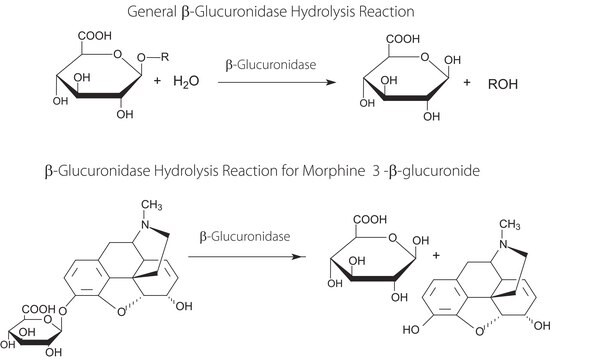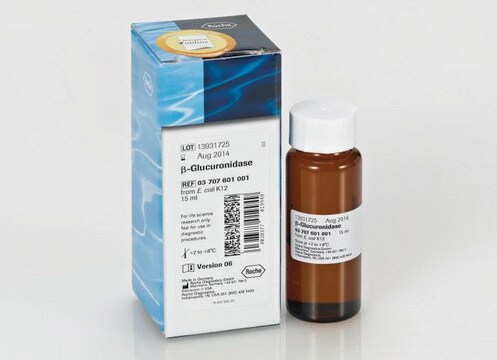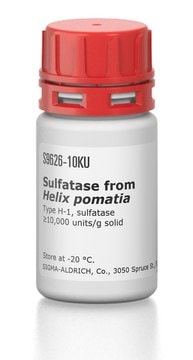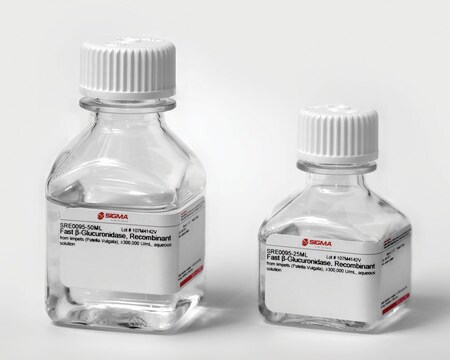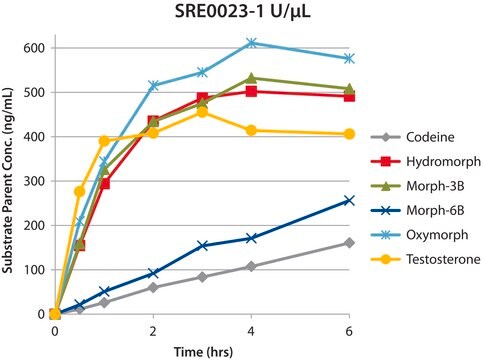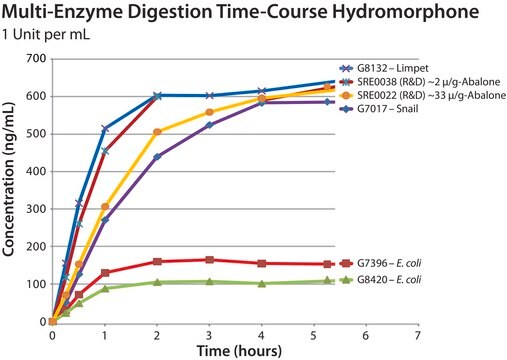Wichtige Dokumente
G8162
ββ-Glucuronidase aus E. coli
aqueous glycerol solution, ≥5,000,000 units/g protein, pH 6.8 (biuret)
Synonym(e):
β-D-Glucuronide glucuronosohydrolase
About This Item
Empfohlene Produkte
Biologische Quelle
Escherichia coli
Qualitätsniveau
Form
aqueous glycerol solution
Spezifische Aktivität
≥5,000,000 units/g protein, pH 6.8 (biuret)
Mol-Gew.
69-71 kDa
Versandbedingung
wet ice
Lagertemp.
−20°C
Suchen Sie nach ähnlichen Produkten? Aufrufen Leitfaden zum Produktvergleich
Allgemeine Beschreibung
Anwendung
The optimal conditions for the enzymatic hydrolysis of α-hydroxytriazolam, one of the major metabolites of triazolam in human urine, were determined using β-glucuronidase Type IX-A.
It is used as a reporter gene in GUS assays to monitor gene expression.
Weitere Informationen
über neue von Sigma R&D generierte Anwendungsdaten zur Optimierung der Hydrolyse für verschiedene Arzneimittelklassen, bei denen Enzyme aus unterschiedlichen Quellen verwendet werden, und die Verwendung eines chromatographisch gereinigten Enzyms zur Verminderung der Wirkung der Esterase-Aktivität, die zur Umwandlung von 6-MAM in Morphin führt
Biochem./physiol. Wirkung
Einheitendefinition
Physikalische Form
Substrat
Vergleichbares Produkt
Signalwort
Danger
H-Sätze
P-Sätze
Gefahreneinstufungen
Resp. Sens. 1
Lagerklassenschlüssel
10 - Combustible liquids
WGK
WGK 1
Flammpunkt (°F)
Not applicable
Flammpunkt (°C)
Not applicable
Analysenzertifikate (COA)
Suchen Sie nach Analysenzertifikate (COA), indem Sie die Lot-/Chargennummer des Produkts eingeben. Lot- und Chargennummern sind auf dem Produktetikett hinter den Wörtern ‘Lot’ oder ‘Batch’ (Lot oder Charge) zu finden.
Besitzen Sie dieses Produkt bereits?
In der Dokumentenbibliothek finden Sie die Dokumentation zu den Produkten, die Sie kürzlich erworben haben.
Kunden haben sich ebenfalls angesehen
Artikel
β-glucuronidase (GUS) enzymes are utilized to hydrolyze glucuronide (gluc) drug metabolites to the parent drug, facilitating analysis by LC-MS/MS.
Today, diverse studies report the benefits of probiotics, such as inhibitory effects on pathogens, aid in the management or prevention of chronic intestinal inflammatory diseases or atopic syndromes, and support to the immune system. Potential beneficial applications abound, researchers continue to evaluate the effictiveness and clarify the mechanisms of action of probiotics.
Protokolle
Enzymatic Assay of β-Glucuronidase (EC 3.2.1.31) from E. coli
Unser Team von Wissenschaftlern verfügt über Erfahrung in allen Forschungsbereichen einschließlich Life Science, Materialwissenschaften, chemischer Synthese, Chromatographie, Analytik und vielen mehr..
Setzen Sie sich mit dem technischen Dienst in Verbindung.